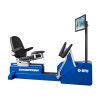
Reimbursement for Athletic Trainers – What You Need To Know
Practice ManagementAthletic Trainers can bill for third party reimbursement in some states. Let’s take a look at how ATCs get reimbursed, building referral sources, CPT coding, and increasing revenue for athletic training facilities
I want to introduce a topic that many of you, Athletic Trainers included, may not have heard of: billing and reimbursement for ATCs’ services. Athletic Trainers CAN bill for third party reimbursement in some states. Let’s take a look at how ATCs get reimbursed, building referral sources, CPT coding, and increasing revenue for athletic training facilities.
There is a great deal of information available on the topic. Joe Greene is one of the most knowledgeable on the topic in the field of athletic training. He states, “All athletic training state practice acts allow for athletic trainers to deliver physical medicine and rehabilitation services that are potentially billable, and most allow for the possibility of billing insurance companies; however, there is a very small percentage of ATCs who are billing successfully and being reimbursed for their services.”1
How Athletic Training Is Funded
Traditionally, people think that ATCs mostly work in high school and collegiate sports settings. Forty years ago, this would have been a pretty accurate assumption. Today, however, Athletic Trainers can be found all throughout various levels of our healthcare system. Not only will you find us in schools, but we can also be found in rehabilitation facilities, manufacturing sites, performing arts, the military, and even here at a medical equipment company.
Normally, an Athletic Trainer is hired and paid based on the need for the service. The financial return for an Athletic Trainer’s services has mainly been tied to liability for coverage at sporting events, as well as prevention, recognition, and treatment of injuries. More recently, Athletic Trainers have become a valuable asset for physical therapy clinics, orthopedic facilities, and hospitals.
Athletic Raining as Revenue
At most facilities, Athletic Trainers’ services are instrumental in the quality, efficiency, and financial success of the business. The hours spent outside of the facility doing outreach to local schools or industry can turn in to an excellent referral or marketing source for the employer. But, historically, there typically has not been a direct source of revenue generated by an Athletic Trainer through reimbursement like that of our OT and PT friends.
Athletic training is not only a profession, it is also a business. The services would not make sense if there were no one to benefit from the presence of an Athletic Trainer or if hiring them were a financial loss. Companies budget for this position as they would any other. They want their investment in this Athletic Trainer to be of mutual interest and benefit to both parties.
Billing Insurance for Athletic Training
Some facilities can generate revenue by billing insurers and third-party vendors for services provided by Athletic Trainers. It depends on what state you’re practicing in. To get started, first visit the National Athletic Trainers’ Association page about billing, as this is an excellent place to learn more about this practice2. Next, check out your state’s regulatory boards practice acts to better understand how an Athletic Trainer is defined and what types of services they can provide3.
Building a Referral Network
If you have done your due diligence and are able to begin billing for services, the next step will be finding referrals. Developing a referral and patient network will be key to financial success. One place to start may be local Physical or Occupational Therapists. Sometimes they may not be able to provide a certain service to a client, and you could be their choice for referrals.
Outside of the rehab / therapy field, you may need to educate or “convince” other referral sources that you are the best option for certain cases. Specifically, educating Physicians on the services that an Athletic Trainer can provide will be pivotal.
For an immersive demonstration, you can invite them to your facility. Let potential referral sources experience the types of treatments and interventions that you will be applying to their patients. In a way, you’ll have to assume the role of a persuasive salesperson who helps them see the benefits you can provide. After all, without the referred clients, the ability to bill and receive reimbursement is not possible.
Billing for Reimbursement
Learning how to bill and code for services can be a job in and of itself. Using codes that are relevant to the services provided are key to reimbursement with less chance of denied claims. This list of CPT codes for athletic training can be a helpful resource in knowing which codes to use for specific evaluations and/or interventions4. You will likely have a rejected claim or two, but you will learn and get better at billing.
Cash Pay for Athletic Training
Another way to increase revenue is with a cash pay model. Countless PT and OT clinics offer cash pay options because it helps reduce billing time. Clients are more willing to pay out-of-pocket when they’re getting an individualized experience with real, quantified results. Having objective equipment that offers engaging treatment like the Eccentron, can help your athletic training practice build revenue from cash payment.
Real Life Example: Paul Higgs’ Success With Third Party Reimbursement
Let’s look at an Athletic Trainer who’s had quite a bit of success with third party reimbursement. I was fortunate enough to learn so much about this topic from the newest member of the Georgia Athletic Trainers Association Hall of Fame, Paul Higgs, Med, LAT, ATC, CSCS. Paul Higgs is the Director of the CEMR Athletic Training Clinic and an instructor for the School of Health Sciences at Valdosta State University in Georgia. Before Valdosta, Paul was the Head Athletic Trainer at Georgia College and State University in Milledgeville for 20 years. It was there where countless other Athletic Trainers and I learned the ropes. And, in the world of athletic training, learning never ends.
I sat down with Paul (via Zoom) to learn more about third party reimbursement for the athletic training profession and how he has successfully incorporated it into the program in Valdosta. He’s been billing insurance companies for athletic training services for about one year, and the additional revenue is already making a difference. He’s been able to generate enough revenue to offset the stipends of two Graduate Assistants.
It might sound like an intimidating venture, but it actually doesn’t change your day-to-day routine much, according to Higgs. Documentation is key to reimbursement (as our PT and OT friends are well aware), and that’s something ATCs already do with each client. Getting started does take time and research up front, but once you determine your eligibility, set up your procedures, and start documenting, it will start to pay off.
Exclusive Q&A With Paul Higgs
Want more athletic training reimbursement tips from someone who’s done it before? Paul Higgs shares how to get started with athletic training reimbursement, which CPT codes he uses, and what he’s learned. Subscribe to TherapySpark to get the exclusive Q&A next month!
In conclusion
Athletic training is a service and a business! Your state may allow you to bill for services and it can be a great way to increase your revenue and may be a way to further justify better equipment or even more personnel. Read your state practice act first. If there are still questions, your local state governing body will be an additional resource. Keep doing the great and meaningful work that you do to help others.
Jeff Johnson, MA, ATC
Clinical Specialist
BTE
References
- Quinn, E. 2020. Third Party Reimbursement Beyond COVID-19. NATA blog. https://www.nata.org/blog/elizabeth-quinn/third-party-reimbursement-beyond-covid-19
- Billing 101: What you need to know. https://www.nata.org/practice-patient-care/revenue-reimbursement/general-revenue-reimbursement/billing-101
- Athletic Training State Regulatory Boards. https://members.nata.org/gov/state/regulatory-boards/map.cfm
- CPT Codes Most Often Used by Athletic Trainers billing for services provided in Clinical Practice. NATA. https://www.nata.org/sites/default/files/RehabCodes.pdf





